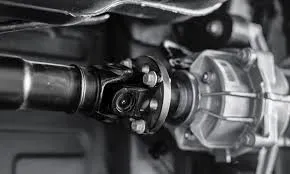Understanding Driveshaft Functionality: The Backbone of Vehicle Performance

When it comes to what makes a vehicle move, the driveshaft often operates behind the scenes, unnoticed yet indispensable. This critical component serves as the bridge between your engine and the wheels, transferring the torque needed to create motion. Without a functioning driveshaft, even the most powerful engine would be rendered useless, leaving the vehicle stationary. Its role is fundamental to your car’s performance, ensuring that the energy produced by the engine is effectively delivered to the wheels.
The driveshaft is often referred to as the backbone of the drivetrain for a reason. It’s engineered to handle high rotational speeds and the constant stresses of transmitting power. Whether you’re navigating city streets, cruising on the highway, or pushing your vehicle to its limits, the driveshaft is working tirelessly to keep the wheels turning smoothly and efficiently.
Despite its importance, many drivers overlook the driveshaft until something goes wrong. Strange vibrations, clunking noises, or difficulty turning could all point to a problem with this vital part. Understanding its function and recognizing its value can help you appreciate the sophisticated engineering of modern vehicles while encouraging regular maintenance to avoid unexpected issues. A well-maintained driveshaft not only ensures a smooth driving experience but also extends the life of your vehicle, making it a cornerstone of reliable performance.
Core Functionality: How Driveshafts Power Your Vehicle
At its core, the driveshaft is the unsung hero of a vehicle’s drivetrain, responsible for transferring the engine’s power to the wheels. It acts as the vital link between the transmission and the differential, enabling your car to move by converting torque into motion. Whether you’re accelerating on a highway or navigating a winding road, the driveshaft ensures that power is efficiently delivered to keep your vehicle running smoothly.
The driveshaft operates by rotating at high speeds, carrying the energy produced by the engine and adjusted by the transmission. In rear-wheel-drive vehicles, the driveshaft connects the transmission to the rear differential, distributing power to the rear wheels. In all-wheel-drive and four-wheel-drive systems, multiple driveshafts work in tandem to transfer power to both front and rear axles, providing enhanced traction and control.
Its design is simple yet highly effective. Made from durable materials like steel, aluminum, or carbon fiber, the driveshaft is built to withstand the intense forces and stress it encounters during operation. It also incorporates universal joints (U-joints) or constant velocity joints (CV joints) to accommodate the movement and flexibility required as the vehicle navigates uneven terrains and sharp turns.
Without the driveshaft, the engine’s energy would have no way to reach the wheels, leaving the car immobile. Its precise operation is crucial for maintaining a smooth driving experience, minimizing vibrations, and maximizing efficiency. By understanding how the driveshaft functions, it becomes clear why this component is essential for any vehicle to perform reliably and effectively.
Types of Driveshafts: Choosing the Right Fit for Your Vehicle
Not all driveshafts are created equal, and their design can vary significantly based on the type of vehicle and its specific needs. Understanding the different types of driveshafts can provide valuable insights into how they impact vehicle performance and why certain designs are better suited for specific applications.
1. Single-Piece Driveshafts
Single-piece driveshafts are commonly found in smaller vehicles or those with shorter wheelbases. They consist of a single, rigid tube that directly connects the transmission to the differential. These driveshafts are lightweight and straightforward, offering excellent efficiency for vehicles that don’t require the added complexity of longer systems. However, they are typically not ideal for larger vehicles or those with significant drivetrain length, as they may be prone to vibrations at high speeds.
2. Two-Piece (or Multi-Piece) Driveshafts
Two-piece driveshafts are more commonly used in Scania truck dealer and service centre, SUVs, and vehicles with longer wheelbases. They feature two interconnected sections, supported by a center bearing, which helps distribute the load and reduce vibrations. This design allows for greater flexibility and stability, making it a preferred choice for vehicles that require longer driveshafts to accommodate their size.
3. Carbon Fiber Driveshafts
For high-performance vehicles, carbon fiber driveshafts are a popular choice. They are lighter than their steel or aluminum counterparts, allowing for faster acceleration and improved fuel efficiency. Additionally, carbon fiber driveshafts can handle higher torque and rotational speeds, making them ideal for sports cars and racing applications. However, their premium performance comes at a higher cost.
4. Constant Velocity (CV) Driveshafts
Found in front-wheel-drive and all-wheel-drive vehicles, CV driveshafts use constant velocity joints to ensure a smooth transfer of power, even as the wheels move up and down over uneven surfaces. These driveshafts are designed for flexibility and consistent power delivery, making them essential for vehicles that require precise handling and performance.
Each type of driveshaft is engineered to meet the unique demands of the vehicle it serves. Whether it’s a compact car, a heavy-duty truck, or a high-performance sports car, selecting the right driveshaft is crucial for optimizing performance, efficiency, and durability. By matching the driveshaft type to the vehicle’s specifications, manufacturers ensure a seamless driving experience tailored to the needs of the driver.
Signs of Driveshaft Problems: When to Seek Repairs
The driveshaft is a durable component designed to handle the rigors of daily driving, but like any part of your vehicle, it can experience wear and tear over time. Recognizing the signs of driveshaft problems early can save you from more extensive and costly repairs down the line. Here are some common indicators that your driveshaft may need attention:
1. Excessive Vibrations
One of the most noticeable signs of a driveshaft issue is excessive vibration while driving. This can occur when the driveshaft is out of balance or if the universal joints (U-joints) or bearings are worn. If left unchecked, these vibrations can lead to further damage to other drivetrain components.
2. Clunking or Knocking Sounds
Unusual clunking or knocking noises, especially when shifting gears or accelerating, may indicate loose or failing components within the driveshaft system. This could include damaged U-joints, worn bearings, or even a misaligned driveshaft.
3. Difficulty Turning or Handling
If your vehicle becomes harder to steer or feels unstable while turning, the driveshaft could be to blame. This is often due to worn CV joints or a failing center bearing in multi-piece driveshafts. Proper alignment and smooth rotation are essential for maintaining control of your vehicle.
4. Shuddering During Acceleration
A noticeable shudder or jerking motion during acceleration is another sign of driveshaft trouble. This could indicate a problem with the driveshaft’s balance, a failing joint, or damage to the shaft itself.
5. Leaking Transmission Fluid
While not always directly related to the driveshaft, leaking transmission fluid can be a secondary issue caused by excessive driveshaft vibrations. This can lead to damage in the seals and surrounding components, which should be addressed immediately to prevent further complications.
6. Complete Loss of Power to the Wheels
In severe cases, a broken or disconnected driveshaft will result in a total loss of power to the wheels. This is a critical issue that requires immediate attention to avoid leaving you stranded.
Addressing these warning signs promptly can prevent more extensive damage to your vehicle’s drivetrain and ensure your safety on the road. If you notice any of these symptoms, it’s essential to consult a qualified technician who can diagnose and repair the problem. Regular maintenance and inspections are key to keeping your driveshaft in top condition and avoiding unexpected breakdowns.
Maintenance and Longevity: Keeping Your Driveshaft in Top Condition
Proper maintenance is essential to ensure your driveshaft operates efficiently and lasts for the long haul. While the driveshaft is built to withstand significant stress, neglecting routine care can lead to performance issues and costly repairs. Here are some key tips to maintain your driveshaft and extend its lifespan:
1. Regular Inspections
Periodic inspections are crucial to identifying wear and tear before they escalate into larger problems. Look for visible signs of damage, such as cracks, rust, or bent sections, as well as wear on the universal joints (U-joints) or constant velocity (CV) joints. A professional mechanic can perform a thorough check, including examining the balance and alignment of the driveshaft.
2. Lubricate Moving Parts
Many driveshafts feature U-joints or CV joints that require regular lubrication to prevent friction and wear. Over time, the grease in these joints can break down or leak, leading to stiffness or failure. Applying fresh lubricant during routine servicing can significantly enhance the lifespan of these components.
3. Monitor Vibrations and Noises
Unusual vibrations or noises, such as clunking or grinding, are often early signs of driveshaft issues. Addressing these problems promptly can prevent further damage to surrounding components, such as the differential, transmission, or axles. A professional diagnosis is recommended to pinpoint the root cause.
4. Avoid Overloading Your Vehicle
Excessive weight or frequent overloading can strain the driveshaft and its supporting components, leading to premature wear. Always adhere to your vehicle’s load limits and distribute weight evenly to minimize unnecessary stress on the drivetrain.
5. Check Alignment and Balance
An unbalanced or misaligned driveshaft can cause vibrations and put additional strain on the vehicle’s drivetrain. Regular alignment checks, especially after off-road driving or hitting road hazards, can help maintain smooth operation and prevent damage.
6. Replace Worn Components Promptly
Parts such as U-joints, center bearings, or CV joints can wear out over time and require replacement. Delaying repairs can result in further damage to the driveshaft or other parts of the drivetrain, increasing repair costs.
7. Protect Against Corrosion
Corrosion can weaken the driveshaft, especially in vehicles exposed to road salt or moisture. Cleaning the underside of your vehicle and applying rust protection can help combat this issue and prolong the life of the driveshaft.
8. Professional Servicing
Routine servicing by a qualified mechanic ensures that your driveshaft and other drivetrain components are functioning properly. Professional technicians have the tools and expertise to diagnose and address issues before they become severe.
A well-maintained driveshaft not only ensures a smooth driving experience but also contributes to the overall efficiency and safety of your vehicle. By incorporating these maintenance practices into your routine, you can avoid unexpected breakdowns and maximize the longevity of this critical component. Regular care and attention go a long way in keeping your driveshaft—and your vehicle—in peak condition.
Driveshaft Innovations: Enhancing Vehicle Performance
Over the years, driveshaft technology has evolved significantly, driven by the demand for improved vehicle performance, efficiency, and reliability. Modern driveshaft innovations incorporate advanced materials, precision engineering, and cutting-edge manufacturing techniques to meet the diverse needs of today’s vehicles. Here are some key advancements in driveshaft technology and how they contribute to enhancing vehicle performance:
1. Lightweight Materials for Improved Efficiency
Traditional driveshafts were primarily made from steel, valued for its strength and durability. However, modern vehicles increasingly utilize lightweight materials such as aluminum and carbon fiber. These materials reduce overall vehicle weight, leading to better fuel efficiency, faster acceleration, and reduced strain on other drivetrain components. Carbon fiber driveshafts, in particular, offer exceptional strength-to-weight ratios, making them a popular choice for high-performance and sports cars.
2. Enhanced Durability for Heavy-Duty Applications
For trucks, SUVs, and off-road vehicles, driveshafts have been engineered to withstand extreme conditions. Reinforced designs and heavy-duty materials ensure that these vehicles can handle high torque, rugged terrain, and demanding loads without compromising performance or safety.
3. Constant Velocity (CV) Technology for Smoother Operation
Advancements in CV joint technology have significantly improved the performance of driveshafts in vehicles with complex drivetrain systems, such as front-wheel-drive and all-wheel-drive vehicles. CV joints maintain a consistent rotational speed, even at sharp angles, resulting in smoother power delivery and better handling.
4. Dynamic Balancing for Reduced Vibrations
Modern driveshafts undergo precision balancing during manufacturing to minimize vibrations during operation. This innovation not only enhances driver comfort but also extends the lifespan of the driveshaft and connected components by reducing wear and tear.
5. Integration with Advanced Drivetrain Systems
As hybrid and electric vehicles gain popularity, driveshaft designs have adapted to integrate seamlessly with these advanced powertrains. Electric driveshafts are now tailored to work with electric motors, enabling efficient energy transfer and optimal performance in a variety of driving conditions.
6. Smart Diagnostics and Monitoring
Innovations in sensor technology allow for real-time monitoring of driveshaft performance. Sensors can detect issues such as imbalance, excessive vibrations, or component wear, alerting drivers or technicians to potential problems before they escalate. This proactive approach to maintenance ensures vehicle safety and reduces downtime.
7. Customizable Designs for Niche Applications
Vehicles with unique requirements, such as race cars, military vehicles, and specialized construction equipment, benefit from customizable driveshaft designs. Manufacturers can tailor driveshafts to specific performance criteria, ensuring that they meet the demands of specialized applications.
Driveshaft technology continues to evolve, setting new benchmarks for efficiency, durability, and performance. These innovations not only enhance the driving experience but also contribute to the overall reliability and longevity of modern vehicles. As automotive technology advances, the driveshaft remains a critical component, embodying the perfect blend of tradition and innovation in vehicle engineering.
Conclusion: The Driveshaft—A Crucial Component in Vehicle Performance
The driveshaft may not be the most visible part of a vehicle, but its importance cannot be overstated. Acting as the backbone of the drivetrain, it ensures the seamless transfer of power from the engine to the wheels, enabling smooth and efficient motion. Understanding its functionality, recognizing potential issues, and staying on top of maintenance can make a significant difference in your vehicle’s performance and reliability.
From lightweight materials to advanced balancing techniques, modern driveshaft innovations have elevated vehicle performance, comfort, and efficiency. Whether you’re driving a compact car, a heavy-duty truck, or a high-performance sports car, the driveshaft is a key player in ensuring your vehicle operates at its best.
By appreciating the role of the driveshaft and investing in regular maintenance, you can enhance your driving experience, avoid costly repairs, and extend the life of your vehicle. A well-cared-for driveshaft isn’t just a technical necessity—it’s a vital component that keeps you moving forward safely and reliably.




